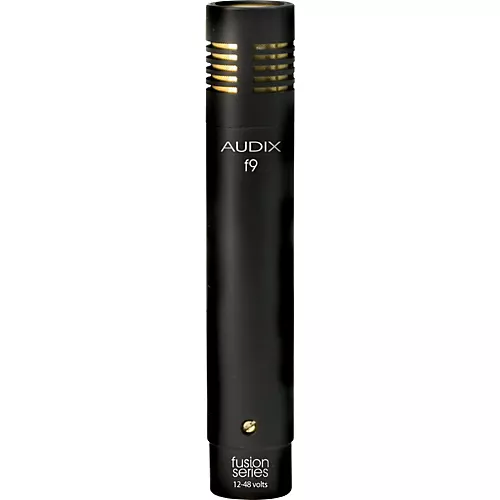Audix F9 Small Diaphragm Condenser Microphone
Quantity
-
DetailThe Audix f9 small-diaphragm condenser mic is known for its clear, accurate response-particularly in the upper-frequency range. Ideally suited for a wide variety of acoustic instruments, the Audix f9 mic is an excellent choice for cymbals, overhead, percussion table, and ambient room miking.With a uniformly controlled cardioid polar pattern, the Audix f9 microphone captures instrument acoustics and at the same time isolates their sounds from the rest of the instruments on stage. The Audix f9 is equipped with a 16mm pre-polarized capsule with a gold vapor diaphragm and a frequency response of 40Hz-20kHz.The Audix f9 is ultra easy to position, durable, and manufactured with high standards and tight tolerances. Its roadworthy construction includes a precision-cast zinc-alloy body, black finish, laser-etched model number, steel mesh grill, gold XLR connector, and a tension-fit heavy-duty nylon mic clip.User tips:The f9, an excellent choice to mic any kind of acoustic instrument. It has a cardioid pick-up pattern, which helps to eliminate sound from other instruments on stage from bleeding into the microphone. However, the f9 is much more sensitive than a dynamic and will pick-up sound from a greater distance. The acoustic nature of the instrument being miked, along with how loud it is, will determine how far the microphone should be from the sound source. For example, the f9 can be placed 1 - 2 feet above the cymbals of a drum kit and still pick up plenty of sound, whereas for a acoustic guitar, the mic will need to be placed within 8 - 12 inches to be effective. Allow a distance of 2-3 feet between microphones to avoid phase issues. Phantom power operation:The f9 will NOT operate without phantom power. The f9 requires 12-48V phantom power, which is available on most professional mic preamps and mixing devices. If phantom power is not available on your equipment, you will have to purchase a phantom power supply (such as the Nady SMPS #180162, or ART Phantom I #180266) ). Avoid plugging or unplugging the microphone from a PA system unless the channel is muted or the volume of the system is turned down. Failure to do so may result in a loud popping noise, which could seriously damage the speakers in the PA system.
-
Customer ReviewsNo comments

 Fender
Fender Gibson
Gibson Taylor
Taylor Martin
Martin lbanez
lbanez Epiphone
Epiphone PRS
PRS Schecter Guitar Research
Schecter Guitar Research Fender Stratocaster
Fender Stratocaster Fender Telecaster
Fender Telecaster Gibson Les Paul
Gibson Les Paul Gibson SG
Gibson SG lbanez RG
lbanez RG Taylor American Dream
Taylor American Dream Taylor GS Mini
Taylor GS Mini Martin GPC
Martin GPC lbanez
lbanez Fender
Fender Squier
Squier Ernie Ball Music Man
Ernie Ball Music Man Sterling by Music Man
Sterling by Music Man Rickenbacker
Rickenbacker Sire
Sire Schecter Guitar Research
Schecter Guitar Research Fender Precision Bass
Fender Precision Bass Fender Jazz Bass
Fender Jazz Bass Fender Mustang
Fender Mustang lbanez SR
lbanez SR Strandberg Boden
Strandberg Boden Yamaha TRBX
Yamaha TRBX Yamaha BB
Yamaha BB Schecter Stiletto
Schecter Stiletto Fender
Fender Marshall
Marshall Orange Amplifiers
Orange Amplifiers Markbass
Markbass Boss
Boss Blackstar
Blackstar Kemper
Kemper Vox
Vox Line 6
Line 6 Electro-Harmonix
Electro-Harmonix MXR
MXR Meris
Meris Dunlop
Dunlop EarthQuaker Devices
EarthQuaker Devices lbanez
lbanez TC Electronic
TC Electronic Alesis
Alesis Roland
Roland Zildjian
Zildjian DW
DW Simmons
Simmons Meinl
Meinl Remo
Remo TAMA
TAMA Pearl
Pearl Vic Firth
Vic Firth Sound Percussion Labs
Sound Percussion Labs Evans
Evans Sabian
Sabian Lp
Lp Yamaha
Yamaha Yamaha
Yamaha Roland
Roland Korg
Korg Williams
Williams Akai Professiona
Akai Professiona Casio
Casio Nord
Nord Moog
Moog Williams Legato
Williams Legato Yamaha Clavinova
Yamaha Clavinova Harbinger
Harbinger Bose
Bose JBL
JBL Electro-Voice
Electro-Voice Behringer
Behringer Yamaha
Yamaha Mackie
Mackie JBL EON
JBL EON Bose L1 Pro
Bose L1 Pro QSC K Series
QSC K Series Yamaha Mixers
Yamaha Mixers Harbinger VAR!
Harbinger VAR! Focusrite
Focusrite Universal Audio
Universal Audio Yamaha
Yamaha PreSonus
PreSonus Tascam
Tascam KRK
KRK Rode
Rode Focusrite Scarlett
Focusrite Scarlett Universal Audio Apollo
Universal Audio Apollo Shure
Shure Sennheiser
Sennheiser AKG
AKG Neumann
Neumann Rode
Rode Sterling Audio
Sterling Audio Audio-Technica
Audio-Technica Warm Audio
Warm Audio AKG 414
AKG 414 Musician Geal
Musician Geal Fender
Fender D'Addario
D'Addario Ernie Ball
Ernie Ball Elixir
Elixir Road Runner
Road Runner Gator
Gator Proline
Proline Remo
Remo Livewire
Livewire On-Stage
On-Stage Hercules
Hercules Mogami
Mogami Dunlop
Dunlop Perri's
Perri's Snark
Snark
